
Sennheiser RS 65 wireless headphones
Review date: 20 October 2004 Last modified 03-Dec-2011.
The basic idea of wireless headphones is a very good one.
Watch TV from the couch in the middle of the night without waking up the family, or having to trail an extension cord across the floor. Head to the kitchen to make yourself a snack in the middle of the show without missing out on the sound. Or head to the bathroom, for that matter; I'm not judging you. Mow the lawn while listening to your favourite CD/MP3/electronically-amplified wax cylinder, without having to use a portable player that you otherwise don't need. Or just use headphones in your office without always tangling the cord around your swivel chair.
The reality of wireless headphones, though, has traditionally not been all that great. Lousy sound reproduction, big fat headsets that either fall off your head when you move or clamp your skull like a playground bully, and, of course, lousy reception.
Old wireless headphone systems use the FM broadcast band, which just doesn't work well without big antennas, which they don't have.
This, however, is Sennheiser's RS 65 radio frequency wireless headphone system. It has none of the problems of the old wireless headphones, and adds a couple of groovy features of its own. It ain't perfect, but boy, it's so much better than what you used to be able to get.
For a start, the RS 65 uses a much higher frequency than the old 108MHz-at-most systems; it's got three selectable frequencies, all around 434MHz for this Australian version ("RS 65-4"), which means its transmit and receive antennae can be a quarter the size of a 100MHz-ish system. There are two other versions of the RS 65 ("RS 65-8" and "RS-65-9") that feature transmit frequencies around 863MHz and 925MHz respectively (three channels for 925MHz, only two for 863MHz), and presumably have different antennas to match; those versions will work here in Australia (power supplies permitting; my Australian RS-65 came with a 220/240V-only plugpack), but will violate local radio spectrum laws. Not that ten milliwatts of transmit power is likely to get yo' ass busted. But if it does, I never said that.
All three versions of the RS 65 operate well below the microwave band where radio waves start to have a very hard time penetrating various materials (to the chagrin of users of 2.4GHz wireless networking products). Sennheiser claim an "up to 100 metre" range for the system, which I suppose it may well achieve if you set it up in the middle of an empty field. But its meagre transmit power does give it enough range to cover the whole of all but the most luxurious houses, plus the surrounding gardens, provided you don't set the transmitter up where it's walled in by steel computer cases, or something.
The RS 65 headphones are also, I'm very happy to say, neither weedy little 80s-Walkman affairs or bulky monsters that pack a couple of C batteries on either side.
At a glance, the headset looks like a "circumaural", around-the-ears type, and that's how Sennheiser describe it. That description's true, but only if your ears are on the small side. The soft velvet cushions are only about seven by nine centimetres in size (2.75 by 3.5 inches) on the outside, with a hole in the middle about 3.5 by 5.5cm (1.4 by 2.2 inches). So they'll sit on top of some people's ears, and at least snuggle up right around the edges of most people's.
The ear-pads are bigger than those of the cheap bass-beast HD 212 Pros I reviewed a while ago, but I still don't think they quite qualify as truly circumaural.
These headphones certainly are light, though. The 'phones by themselves, with their battery, weigh only about 170 grams (six ounces).
Because they're so light, and because they're open-backed (not sealed to exclude outside noise) these headphones don't have to clamp your head very hard to stay on. That's good, because ear-pads that sit on your ears and push down hard are never good ergonomic news. The RS 65 headphones aren't incredibly comfortable, but most people should be happy to wear them for hours on end.
There's also a useful amount of size adjustment in the headband - it goes small enough for kids, and big enough for all but the hugest of heads. There's a nice velvety cushion on the underside of the headband too, of course.
The earphone controls and battery are all on the right earpiece - which, oddly enough, has to be on the left when you plug the headphones into the base station to charge. The extra stuff doesn't make the right side of the headphones noticeably heavier, though, and the controls are easy to use. There's one thumbwheel for volume, one Tune button that causes the headphones to automatically find which of the transmit channels the base station's currently using (if there's more than one base station transmitting on different channels, the headphones will cycle through them when you press Tune), and one simple on/off switch.
Here's the side with the Tune button. I've removed the battery for this picture; it's easy to slide it out. The battery's a tiny little nickel metal hydride (NiMH) thing, with a mere 2.4V, 70 milliamp-hour (mAh) rating. That gives it a nominal energy content of 168 milliwatt-hours, or about a fifteenth of the energy an unremarkable AA NiMH cell can hold.
Sennheiser claim this tiny battery will give you more than four hours of run time per charge. They're almost telling the truth; three to four hours is a better estimate. Given the 70mAh capacity of the batteries and Sennheiser's own 19.5mA current consumption figure, you can only expect 3.6 hours per charge. And that'll fall as the battery ages; NiMH cells don't last forever.
Even only three hours, though, is likely to be OK, because...
...there's a second battery included with the RS 65 package, and it charges in a little bay at the back of the base station, ready to swap into the headphones.
The charger's a slow-and-gentle trickle unit that takes 14 hours to refill a battery, so two batteries won't let you listen non-stop for a lot more than seven hours. All but the most interminable of cinematic diversions, of course, will be over before the first battery goes flat. If you have to, though, it's no big deal to swap batteries as part of a toilet/popcorn/beverage break.
The base station's quite lightweight too, because it doesn't contain any power-supply components. It runs from an external plugpack that connects to the base via a mildly perverse little two-pin plug, instead of the usual barrel connector. You also, of course, get an audio input lead; it's 1.9 metres long (six feet, three inches), has a standard 1/8th inch stereo plug on one end (with a 1/4 inch adapter), and another of those odd little micro-plugs on the end that plugs into the base station.
The headphones plug into the base station for charging pretty easily; two tabs on the sides of the station slide into slots on the 'phones, and one of the tabs has the charge contacts on it. You don't have to slide the headband down to its minimum size to fit the 'phones into the base, though it's easier if you do.
On the front of the base station there are only two buttons - one to select the transmit channel (one LED goes on for channel 1, the other for channel 2, both for channel 3), and another that lets you toggle an SRS stereo expander. SRS expansion does for your sound what the dreadful expanders of the 70s and 80s only promised to do; it genuinely widens the stereo soundstage, without turning the bass into a rumbly mess or making you feel as if you've got a head cold. SRS expansion is completely unacceptable by any audiophile's standards, of course, but many people like it a lot, and it's not as if the RS 65 makes you use it.
Pricing
Because of the three different frequency variants, you can't really compare RS 65 models across countries, and you have to expect the less common variants - like the one I reviewed, with Australian plugpack and Aussie-legal frequency - to cost more. Shoppers in places like Australia are sometimes well advised to personally import things like headphones from cheap dealers overseas, but that isn't the case for the RS 65s. The local price would have to be really ludicrous to justify fooling around with incompatible power supplies and illegal frequency bands.
In the USA, HeadRoom sell the RS 65-8 for $US189.99 ex delivery. Unusually for HeadRoom, this isn't around the lowest price you can pay; quite a few US dealers seem to have RS 65s for less than $US150 ex shipping, and some of them aren't even Yahoo stores or rated at one out of ten. HeadRoom are a Real Headphone Store, though, who'll answer your e-mails and explain stuff to you, so you might like to shop there anyway.
Here in Australia, Aus PC Market sell the RS 65-4 for $AU396 including delivery anywhere in the country (Australians who'd like to buy a set can click here to do so!).
As I write this, HeadRoom's US ex-delivery price works out at only around the $AU260 mark, and delivery doesn't cost that much. Take delivery into account and even HeadRoom's non-rock-bottom US price is about 70% of the Australian one.
That's not too bad, though, when you consider that the 65-8 and 65-4 are actually different products, and somebody did have to ship the things to this country and handle warranties. I've groused about Australian prices for various headphones before, but the RS 65s here aren't terribly expensive, by world standards. They're not a giant bargain, either, but I won't be marching around outside the distributors' office holding a placard over this price.
Extra stuff
If you need more batteries for your RS 65, they currently start from less than $US20; HeadRoom's price is perfectly OK. If you've still got your RS 65s ten years from now and you can't find the batteries any more, you shouldn't be completely out of luck; bare NiMH cells in all shapes and sizes should be available for a long time yet, and anyone handy with a soldering iron should be able to crack the battery casing and replace the two tiny cells inside. NiCd and NiMH battery "re-celling" is easy to do; lithium-ion re-celling is fraught with exciting risks.
You can also buy whole extra "HDR 65" headsets, which each come with one battery. HeadRoom stock them for $US119, though those ones are of course not useful for people who don't have an 863MHz base station.
You can use as many headsets as you like with one RS 65 base station, though charging several sets will be annoying unless you also invest in the separate L 151-2 charger. That charger's existence seems to be documented only in German (and PDF, sort of), but it's available here and there for $US30-odd. There's also a much more expensive ten-slot L 151-10 charger, by the way, in case you're thinking of kitting out a movie theatre with no speakers in it.
Hooking up
The RS 65's designed to plug into a headphone socket, not a line out. It's got very high input impedance (20 kilo-ohms across the right and left contacts on the plug), so the power of the amp it's plugged into is completely irrelevant. Hi-fi component, PC, laptop, portable player, whatever, all should work. Quirky amps that exhibit frequency response weirdness when they are, as far as they can see, completely unloaded may dirty up the sound, but I had no such problems in my testing.
The rest of the hook-up process is easy - two cables, and you're done. Then you get to sit for 24 hours for the first battery charge if you're an obedient manual-reader (PDF here), or rather fewer hours if you just can't wait.
Listening
By the standards of old cordless headphone systems, the RS 65s when they're not far from their base station are a revelation. Not because of the greatness of the sound, per se, but because of its incorruptibility. You can turn around, walk through doors, stick your head in the fridge, and not hear a single bit of interference.
By modern cabled headphone standards, though, they're... well, they're OK. Their chief sin is a lack of treble. Sennheiser claim a 20 to 20,000Hz frequency range for the headphones, which may well be true, but the base station just doesn't seem to send that much treble to the headset (or maybe the noise reduction eats it), so they sound distinctly muffled. Judicious use of equalisation (or, in a pinch, the Treble knob) can put most of the sparkle back, though.
A lot of cheaper headphones distinctly compress the stereo soundstage, because they're not very good at reproducing the fine frequency and phase differences that the brain uses to decode this information. The RS 65s have a middling dose of this problem, but I don't know how much of it is the fault of the headphones and how much the fault of the radio system. Either way, I found very little need for crossfeed processing, though the SRS expansion was still well over the top for most music listening, if you ask me.
The RS 65 is an OK bass performer. There's a bit of overemphasis in the mid-bass, but it's not ridiculous, and that's actually what many cordless headphone listeners want. A bit of extra bass poke goes well with many movies, for instance.
Really big bass tracks at high volume can overwhelm either the transmitting encoder or the headphones' amplifier, to the point where you get quite a lot less low bass when you turn the SRS expansion on. This isn't much of a problem, though; it's just a sign that you should turn the darn volume down before you damage yourself.
If you must have really ear-bleeding volume, the RS 65s can't quite oblige. The low-power amp in the headphones only goes so far. I had no trouble pushing my test tracks into the headache-in-20-minutes zone, though, which is rather louder than is wise. If you want to wear headphones while mowing the lawn then a sealed system (that blocks external noise and so doesn't need as much volume) will work better than the open RS 65s, but the flip side of this is that the RS 65s don't have very much sound coloration. Open headphones sound better than closed ones, all things being equal, and within their frequency-response limits the RS 65s seem quite clean.
There's also not much background noise. You can hear a distinct hiss when you wind the headphone volume up with nothing playing, but it's usually unobtrusive. Unless the base station's asleep, that is. When the base doesn't receive an input signal for about three minutes, it stops transmitting, and the headphones start making little random noises when bits of background RF make it past their filtering. The base station powers up automatically when the signal comes back, of course, and it'll keep charging batteries whenever it's plugged into the mains.
Overall, I found the RS 65s disappointing to listen to whenever I switched to them from my fairly-good HD 590s, but I got used to them pretty quickly, especially with some treble-boost EQ. Corded headphones that sound like this would only be worth $AU50-odd, but you'd need a whole bunch of extension cords to get similar functionality out of them.
Range testing
The radio technology the RS 65 uses is still plain old FM encoding, not one of those fancy digital systems the kids are so crazy about these days. But FM at a higher-than-regular-broadcast frequency with a bit of noise-rejection tech works just fine, thanks.
I've only tried out this 434MHz version, which may or may not have better performance than the higher frequency versions - lower-frequency radio waves penetrate things better, but they need bigger antennas for the same gain, so Sennheiser may have put lower-gain antennas in the RS 65-4, cancelling any advantage.
Anyway, my test headphones managed a real-world range of better than fifty metres (55 yards), when I set the base station up on top of a monitor in my first floor office (that's one floor above ground level, USAnians) and went for a walk on the street outside, looking like a dork in the name of science.
At 50 metres there were already occasional rushing-hashing noises, familiar to everybody who's listened to FM on a portable stereo, but I was still quite happy with the overall quality. I could go rather further without the signal breaking up completely, but I wouldn't bet on more than 50m in any non-football-field situation. Extra walls and trees and such could cut it down significantly further.
Even if your house is sitting on a square one-acre block, though, the middle of the block's only going to be 45 metres away from the corners. For most people in home or work settings, the range of the RS 65 should be ample.
Overall
There are lots of corded headphones around the RS 65 price point that sound really good. The RS 65 doesn't. It sounds... adequate. Not crap. Better than what a lot of people put up with, but that's it.
But the trade-off you get for paying really-good-headphone money for adequate-headphone sound is freedom. It took me a few goes before I could control my take-the-headphones-off reflex every time I got up from my desk, but I got the hang of it eventually. Uninterrupted music in the kitchen, the bathroom, out on the balcony, wherever. Nothing tickling my arm when I turned my head, nothing getting hooked behind the armrest or steamrolled under the casters of my chair. Nice.
Would I buy these things? Probably not. Headphone music all over the house just isn't that important to me. I don't mind stopping the music to go and do things, and the dangling cord is no more than a minor annoyance.
That's just me, though. If you want to extend your audio to the shop floor, garden, workshop or whatever, and especially if you like the idea of buying multiple headsets so a bunch of people can listen at once without annoying another bunch of people, the RS 65 is an excellent product.
It could stand to be cheaper, yes, but it costs this much for a reason. Recommended.
Buy stuff!
Aus PC Market don't sell these headphones any more, but they've got
several
other wireless models!
US shoppers might like to check out HeadRoom.
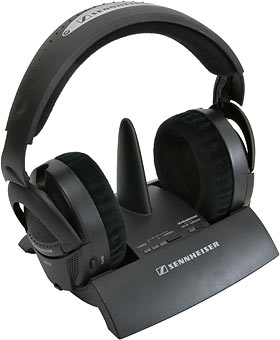
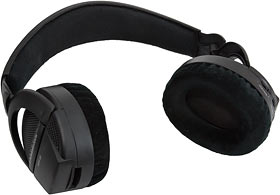
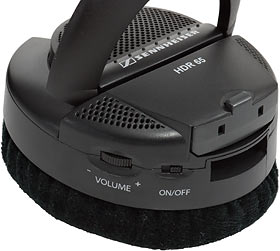
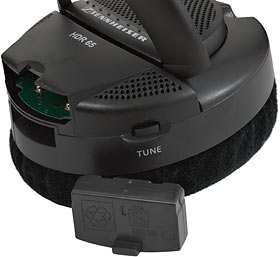
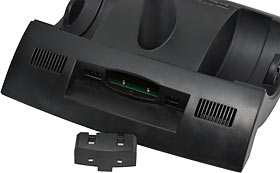
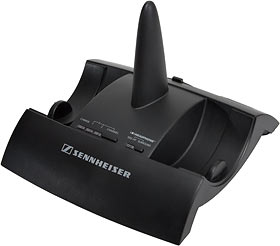
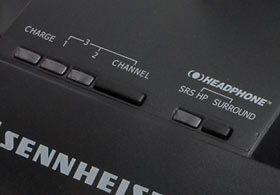

![[SecureWebs]](images/sw.gif)